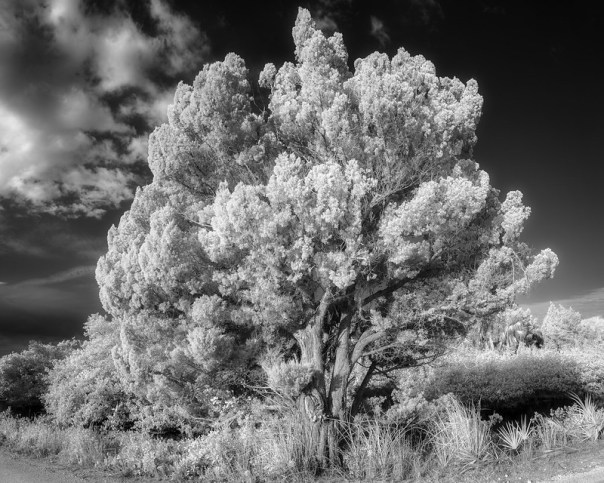Good morning! We were traveling last weekend and I started coming down with a cold on the flight back. So I haven’t been out much since and I don’t have any new material for you. Instead, I’ll repost this write-up from back in April, 2014 – it’s one of my favorites. And it reminds me I need to go back over there and see what’s changed! You can also look at this post for more info on the location: https://edrosack.com/2014/01/04/marineland-beach/
There were a few lights in the parking lot way back behind the sand dunes and the clouds were thick and low, making it so very dark on Marineland Beach south of St. Augustine, Florida that my first few exposures didn’t even register on the sensor. I kept raising exposure times and ISO until I was able to capture this:

99 seconds in the dark – ISO 400, 99 seconds @ f/8; Marineland Beach, about 45 minutes before sunrise.
It sure didn’t look this way to my eyes. I couldn’t see much at all and had to use my head lamp to compose and focus.
When I got home and processed the photos, they reminded me of some things that might be useful to others.
Pre-visualize before, during, and after you press the shutter
You should always try to pre-visualize the photo you’re making before you compose and shoot – and it’s a delightful feeling when the image turns out just like you imagined. But this is often harder than it sounds. Especially if you can’t see what you’re photographing. There’s nothing wrong with adjusting your vision as you go. This is a wonderful advantage of digital cameras that we’d be foolish to ignore. Check your results on the LCD during the shoot and adapt as necessary. In this case, I knew exactly what I needed to change when I first looked at my (black) LCD. I needed more exposure!
Pre visualization is great, but there’s also nothing wrong with post visualization. What I mean is to try as many things as you can think of while you’re there and sort it out later when you get home. Try HDR, panoramas, high tripod, low tripod, and focus stacking. Use different focal lengths, shutter / aperture combinations, and positions / directions. Exploit changing weather / light as time goes on. Capture them all and give yourself a better chance to come out with something you like.
Shutter speed
Shutter speed is a critical variable when photographing moving water. The 99 second exposure above gave me very smooth and milky looking water, nicely outlining the rocks. A 1/1000th second (or faster) exposure can freeze drops of water. In between, you can find other speeds that look very different from the extremes. Capture the scene with different shutter speeds when possible. In this 1 second exposure, I like the added interest from the flow patterns in the water.

Marineland Beach and coquina rocks – ISO 100, 1 second @ f/4 with 8 2/3 stop neutral density filter, ~30 minutes after sunrise.
High Dynamic Range (HDR) processing and ghost removal
There are so many controls and sliders in HDR software that it’s hard to know which ones to change. Most HDR software has an option for removing “ghosts” (differences between multiple frames for anything moving in the image) and I think it’s a critical setting. HDR Efex allows me to select the baseline frame I want to use as well as the amount of ghost removal to apply. I like to experiment with these and select the combination that looks best. In the image below, there was only one setting that showed the breaking wave. And I think the wave definitely adds to the image.

Golden rocks and sand – 5 image bracket (-4 to +4 stops), almost an hour after sunrise.
Don’t leave too soon
I made these three images (and more!) over a period of 90 minutes. The changing light provided different looks and opportunities to photograph this place. It’s worth getting there early and staying for a while.
Don’t get overwhelmed
When you visit a beautiful place, especially for the first time – it’s easy to be overwhelmed and forget about everything except pressing the shutter button. It helps to visit multiple times. The first time, it’s hard to see all the possible compositions until you get over the novelty and excitement. When you can relax and enjoy the experience you can open your mind and get in the zone. Then you’ll make images you’ll be happy to share with others.
You can see more of my photos from Marineland in this set on Flickr.
Thanks for stopping by and reading my blog. Now – go make some photos!
©2014 and 2018, Ed Rosack. All rights reserved.

















































